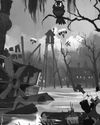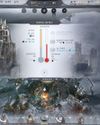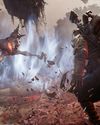
On her first trip away from home, in a Burbank, California, mall filled with CRT monitors and Quake fans, Lorie Kmiec Harper’s mouse broke. It was 1997, and Harper, a 23-year-old assistant warehouse manager from Ontario, was playing as a finalist in the first-ever All Female Quake Tournament under the handle Temperance. “I got kicked out first, you know that, right?” Harper says. “I was number one in Canada, or I was that year,” she reminisces. “But I was eighth in the world.”
In another scenario, Harper’s busted mouse might not have been a big deal. “I don’t know how attached you are to your mouse, but for gaming purposes, it was really bad timing,” she says. She’d spent the previous month training for the finals, playing with people all over the world, sometimes in the middle of the night. It was the first time she’d gotten a passport, and she was excited just to have made it to LA with her plus-one— her then-boyfriend, a computer engineer who had built her first gaming rig.
The other finalists came from all over North America: Bridget ‘t0nka’ Fitzgerald blew off her freshman orientation at Juilliard to play at the finals (“My teacher was like, you are leaving to do what?!” she recalls). Kornelia ‘Kornelia’ Takacs had made a name for herself at the GDC Ten Tournament earlier that year. Stevie ‘Killcreek’ Case was a competitive player infamous for beating Quake designer John Romero in a highly publicized deathmatch. Rounding out the final eight were Aileen ‘Shadyr’ Carlstrom, Mars, LaEl, and Queen Beeatch.
This story is from the {{IssueName}} edition of {{MagazineName}}.
Start your 7-day Magzter GOLD free trial to access thousands of curated premium stories, and 9,000+ magazines and newspapers.
Already a subscriber ? Sign In
This story is from the {{IssueName}} edition of {{MagazineName}}.
Start your 7-day Magzter GOLD free trial to access thousands of curated premium stories, and 9,000+ magazines and newspapers.
Already a subscriber? Sign In

"The War Within itself has kept me coming back most evenings too"
WORLD OF WARCRAFT remains my jailer, and I couldn't be more pleased about it

OK BUILDER
SATISFACTORY is the new titan in building and crafting games

HELL YES
DIABLO IV: VESSEL OF HATRED is a transformative expansion

MOUSE: PI FOR HIRE
This mouse wants to be more than just a gimmick

WINDBLOWN
Dead Cells dev's new roguelike has me afraid for my free time

NO MORE ROOM IN HELL 2
As the zombie horde surrounded me just moments after taking down my two remaining teammates, the writing was really on the wall. Armed with just a chef's knife, it was clear I stood no chance, but I was going down swinging, hoping for a miracle... it didn't come.

OWNED BY STEAM
VALVE cordially reminds you that your games aren't yours

CURSE OF THE AZURE BONDS
These classic games haven't aged badly, but I sure have.

DEEP FREEZE
Endure a blizzard of tough choices and rough consequences in FROSTPUNK 2

NEW HORIZONS
Building up REMNANT 2 outside the live service game grinder